Italian physicist Gian Alessandro Majocchi made history in 1842 as the first person to attempt photographing a solar eclipse. He captured a highly detailed image on a sheet of copper plated with silver using the daguerreotype technique, despite only achieving partial success. In 1851, Johann Julius Friedrich Berkowski at the Royal Prussian Observatory in Königsberg took the first successful picture of a solar corona.
In 1900, Thomas Smillie, a photographer working for the Smithsonian Institution, documented a solar eclipse by rigging cameras to seven telescopes and successfully made eight glass-plate negatives. His work was considered an amazing photographic and scientific achievement. Victorian-era female astronomer Annie Maunder also made history in 1898 when she traveled to India to capture the total solar eclipse. She captured an enormous ray-like structure bursting from the Sun, known as a coronal streamer. Maunder’s expedition to India was focused solely on capturing this remarkable event.



